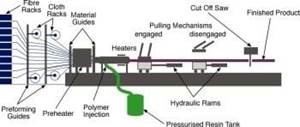BMW cars again a composites showcase at JEC World 2016
BMW AG (Wolfsburg, Germany), already notable for its progressive use of composite materials in its i3 and i8 automobiles, provided the Parisian canvas for a palate of composites innovations.
BMW AG (Wolfsburg, Germany), already notable for its progressive use of composite materials in its i3 and i8 automobiles, provided the Parisian canvas for a palate of composites innovations.
A novel all-carbon fiber composite hood developed by Cytec Industrial Materials HQ (Heanor, UK) in cooperation with fabricator C-CON GmbH (Munich, Germany) and automo- tive metals specialist Läpple AG (Heilbronn, Germany) made its debut on the BMW M4 GTS. Prototyped in just nine months, it represents a substantial step-change in auto parts fabrication and shows how composites molding can be adapted to fit within an established automotive manu- facturing supply chain.
BMW approached C-CON with the idea of converting the M4 GTS hood from aluminum to carbon fiber composites. C-CON turned to Cytec (at the time, not yet acquired by Solvay Composite Materials) for help developing the required materials and processes. Alex Aucken, Cytec Solvay’s global automotive director, Industrial Materials, says the tight development window put tremendous pressure on all involved, but in the end, the material/process not only produced a hood 40% lighter than its aluminum predecessor, but also could be viable and cost-effective in other applications. The 8-kg hood consists of a 1.2-mm thick, Class-A outer panel bonded to a 1.2-mm thick inner structure, with additional carbon fiber composite hinge reinforcements near two corners. Aucken and Tim Wybrow, application research and engineering manager at Cytec Solvay, say that the process involves in-situ application of novel MTR 760 epoxy, developed by Cytec for the application, on a 24K tow carbon fiber just prior to filament winding around a 1m diameter mandrel, in an optimized but atypical angle and layer configuration. After winding, this prepregged layup is removed from the mandrel and then slit to create a flat blank, which is large enough to provide material for as many as three tailored inner- or outer-panel blanks.
For consolidation and cure, a blank is placed flat between two thermoplastic films, which are clamped in place, under tension, by a metallic frame. This double-diaphragm forming process, says Aucken, obviates the need for preforming and allows the carbon fiber blank to take the sometimes very complex shapes required, with minimal wrinkling. The frame is then placed in a metal mold in a compression press and cured in less than 5 minutes. C-CON handles filament winding and blank preparation. Läpple does the molding, trimming, cutting and assembly.
Notably, the team set out to develop a composites fabrication process that would enable Läpple to convert to composites without the capital equipment investment for a press, so the hood is molded on a metal-forming press. “We have to fit into the existing infrastructure,” says Wybrow.
The hood meets BMW’s cost, strength, stiffness and pedestrian-safety requirements, has a void content of 1.2%, and its Class A surface is easily paintable.
On the Hexion Inc. (Columbus, OH, US) stand, Dr. Francis Defoor, global market segment leader, transportation, discussed the carbon fiber roof arc for the BMW 7-Series, made via HP-RTM with Hexion’s Epikote Resin TRAC 06000 epoxy. It uses a proprietary core technology and offers a cure time of about 60 seconds, Defoor said. The build rate right now is 80,000 units/year, with a target of 100,000-200,000 units per year. Hexion, like many other material suppliers, also is establishing a research technical center, in Germany, to develop HP-RTM, liquid compression and compression molding. Thinking more broadly, Defoor argued that composites fabricators for automotive are still grappling with efficiency and cost requirements imposed by OEMs, but he believes that composites cycle time chal- lenges have largely been solved. What remains, he said, is to solve material handling challenges, which will require more intense application of automation and robotics.
Hexcel (Stamford, UK) also emphasized at JEC its BMW connection, discussing the use of its HexPly M77 UD carbon fiber prepreg in the BMW 7-Series car’s B-pillar (see photo), manufactured in a 90-second-cure process, with automated cutting and in-situ inspection, to produce 500 units/day.
Related Content
Pultrusion: The basics
A primer describing what pultrusion is, its advantages and disadvantages, and typical applications.
Read MoreCombining multifunctional thermoplastic composites, additive manufacturing for next-gen airframe structures
The DOMMINIO project combines AFP with 3D printed gyroid cores, embedded SHM sensors and smart materials for induction-driven disassembly of parts at end of life.
Read MoreA new era for ceramic matrix composites
CMC is expanding, with new fiber production in Europe, faster processes and higher temperature materials enabling applications for industry, hypersonics and New Space.
Read MorePlant tour: Spirit AeroSystems, Belfast, Northern Ireland, U.K.
Purpose-built facility employs resin transfer infusion (RTI) and assembly technology to manufacture today’s composite A220 wings, and prepares for future new programs and production ramp-ups.
Read MoreRead Next
VIDEO: High-volume processing for fiberglass components
Cannon Ergos, a company specializing in high-ton presses and equipment for composites fabrication and plastics processing, displayed automotive and industrial components at CAMX 2024.
Read MoreAll-recycled, needle-punched nonwoven CFRP slashes carbon footprint of Formula 2 seat
Dallara and Tenowo collaborate to produce a race-ready Formula 2 seat using recycled carbon fiber, reducing CO2 emissions by 97.5% compared to virgin materials.
Read MoreDeveloping bonded composite repair for ships, offshore units
Bureau Veritas and industry partners issue guidelines and pave the way for certification via StrengthBond Offshore project.
Read More












.jpg;maxWidth=300;quality=90)








